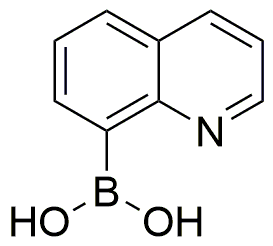Quinoline-8-boronic acid is widely utilized in research focused on:
- Drug Development: This compound plays a crucial role in medicinal chemistry, particularly in the synthesis of new pharmaceuticals. Its boronic acid functionality allows for the formation of stable complexes with biomolecules, aiding in drug design.
- Organic Synthesis: It serves as a versatile building block in organic synthesis, enabling the creation of complex organic molecules. Researchers often use it in cross-coupling reactions, which are essential for constructing carbon-carbon bonds.
- Fluorescent Probes: Quinoline-8-boronic acid can be employed in the development of fluorescent probes for biological imaging. Its ability to bind selectively to certain biomolecules enhances the sensitivity and specificity of imaging techniques.
- Material Science: In the field of materials science, it is used to modify surfaces and create functional materials. Its unique properties can improve the performance of sensors and catalysts.
- Environmental Monitoring: This compound can be utilized in the detection of environmental pollutants. Its reactivity with specific contaminants allows for the development of sensitive analytical methods for monitoring water and soil quality.
General Information
Properties
Safety and Regulations
Applications
Quinoline-8-boronic acid is widely utilized in research focused on:
- Drug Development: This compound plays a crucial role in medicinal chemistry, particularly in the synthesis of new pharmaceuticals. Its boronic acid functionality allows for the formation of stable complexes with biomolecules, aiding in drug design.
- Organic Synthesis: It serves as a versatile building block in organic synthesis, enabling the creation of complex organic molecules. Researchers often use it in cross-coupling reactions, which are essential for constructing carbon-carbon bonds.
- Fluorescent Probes: Quinoline-8-boronic acid can be employed in the development of fluorescent probes for biological imaging. Its ability to bind selectively to certain biomolecules enhances the sensitivity and specificity of imaging techniques.
- Material Science: In the field of materials science, it is used to modify surfaces and create functional materials. Its unique properties can improve the performance of sensors and catalysts.
- Environmental Monitoring: This compound can be utilized in the detection of environmental pollutants. Its reactivity with specific contaminants allows for the development of sensitive analytical methods for monitoring water and soil quality.
Documents
Safety Data Sheets (SDS)
The SDS provides comprehensive safety information on handling, storage, and disposal of the product.
Product Specification (PS)
The PS provides a comprehensive breakdown of the product’s properties, including chemical composition, physical state, purity, and storage requirements. It also details acceptable quality ranges and the product's intended applications.
Certificates of Analysis (COA)
Search for Certificates of Analysis (COA) by entering the products Lot Number. Lot and Batch Numbers can be found on a product’s label following the words ‘Lot’ or ‘Batch’.
*Catalog Number
*Lot Number
Certificates Of Origin (COO)
This COO confirms the country where the product was manufactured, and also details the materials and components used in it and whether it is derived from natural, synthetic, or other specific sources. This certificate may be required for customs, trade, and regulatory compliance.
*Catalog Number
*Lot Number
Safety Data Sheets (SDS)
The SDS provides comprehensive safety information on handling, storage, and disposal of the product.
DownloadProduct Specification (PS)
The PS provides a comprehensive breakdown of the product’s properties, including chemical composition, physical state, purity, and storage requirements. It also details acceptable quality ranges and the product's intended applications.
DownloadCertificates of Analysis (COA)
Search for Certificates of Analysis (COA) by entering the products Lot Number. Lot and Batch Numbers can be found on a product’s label following the words ‘Lot’ or ‘Batch’.
*Catalog Number
*Lot Number
Certificates Of Origin (COO)
This COO confirms the country where the product was manufactured, and also details the materials and components used in it and whether it is derived from natural, synthetic, or other specific sources. This certificate may be required for customs, trade, and regulatory compliance.


